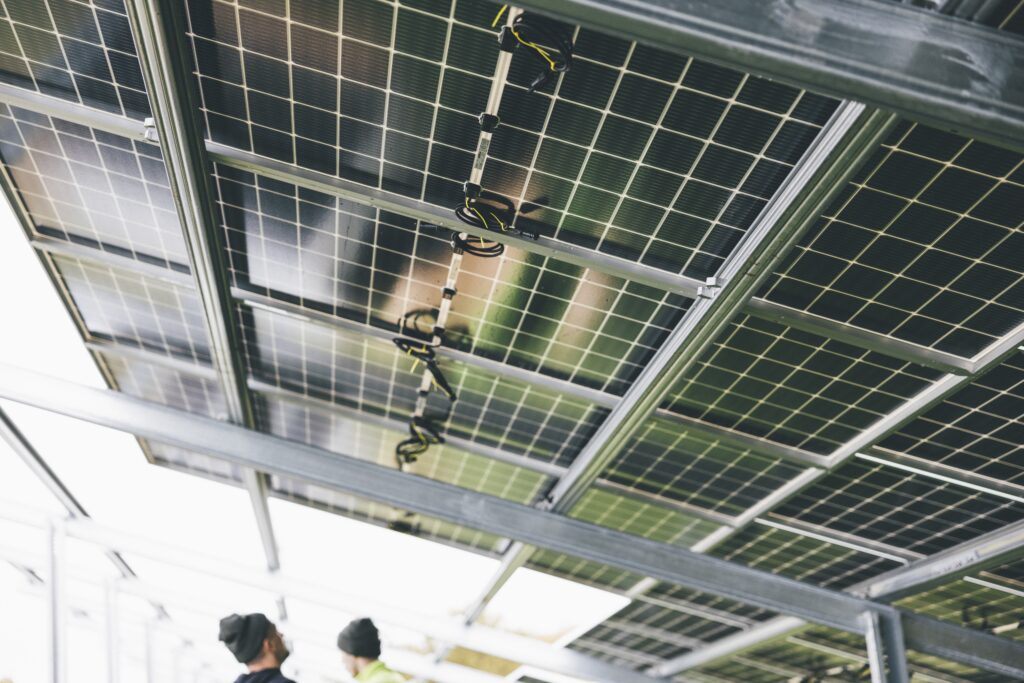In the face of the pressing challenges posed by climate change, the role of technology cannot be overlooked. It presents us with immense opportunities to actively combat this global crisis. From renewable energy sources to innovative carbon capture techniques, technology holds the key to minimizing our carbon footprint and paving the way towards a more sustainable future. In this article, we explore the various ways in which technology can play a vital role in tackling climate change.

Check Out Our Top Eco Friendly Product Picks On Amazon Here
Renewable Energy
Renewable energy is a key solution in combating climate change, and technology plays a crucial role in harnessing these sustainable sources. Solar power, for example, utilizes photovoltaic cells to convert sunlight into electricity. These cells are becoming increasingly more efficient, which means we can generate more power with less sunlight. Solar panels also have a long lifespan and require minimal maintenance, making them a reliable and cost-effective renewable energy option.
Similarly, wind power is another viable and clean energy source. Advances in wind turbine technology have led to more efficient and powerful turbines that can capture the energy from even low wind speeds. These turbines are designed to rotate and generate electricity as the wind blows, contributing to a greener grid. Additionally, wind farms can be built offshore, reducing the visual impact and utilizing strong wind resources for maximum energy production.
Hydropower is another renewable energy source that harnesses the power of flowing water to generate electricity. Technology has allowed us to develop low-impact hydropower systems, such as run-of-river and small-scale hydroelectric facilities, that minimize the environmental impact on rivers and ecosystems. By capturing the energy from flowing water, we can generate electricity without producing harmful emissions or depleting finite resources.
Energy Efficiency
In addition to transitioning to renewable energy sources, improving energy efficiency is crucial in tackling climate change. Smart grids are a technological advancement that allows for more efficient distribution and management of electricity. These grids use sensors and real-time data to optimize energy usage, reduce wastage, and detect and respond to power outages more effectively. By integrating renewable energy sources into the grid and optimizing energy consumption, smart grids help reduce greenhouse gas emissions and make our energy system more resilient.
Energy-efficient appliances also have a significant impact on reducing energy consumption. From refrigerators to lighting fixtures, advancements in technology have allowed for the development of more energy-efficient options. These appliances are designed to use fewer resources while maintaining high performance. By replacing outdated and energy-intensive appliances with energy-efficient ones, we can lower our energy consumption and reduce the demand for fossil fuels.
Building automation is another technology that can greatly enhance energy efficiency. Smart building systems use sensors and algorithms to control and optimize various aspects of a building, including heating, ventilation, and lighting. By continuously monitoring and adjusting settings based on occupancy and external factors, buildings can significantly reduce energy waste. Moreover, optimizing building operations improves occupant comfort and productivity while reducing greenhouse gas emissions associated with energy consumption.
Check Out Our Top Eco Friendly Product Picks On Amazon Here
Carbon Capture and Storage
Carbon capture and storage (CCS) technologies aim to capture carbon dioxide emissions from industrial processes and store them underground, preventing them from entering the atmosphere. One approach is direct air capture, which uses large-scale machines to remove CO2 directly from the air. This captured carbon can then be stored or used in various industries. Direct air capture has the potential to offset emissions from difficult-to-decarbonize sectors, helping to mitigate climate change.
Industrial carbon capture involves capturing CO2 emissions from industrial processes, such as power plants and cement production facilities, before releasing them into the atmosphere. By capturing these emissions and storing them underground, we can prevent substantial amounts of greenhouse gases from contributing to climate change.
Bioenergy with carbon capture and storage (BECCS) is an emerging technology that combines the use of biomass energy production with CCS. By utilizing renewable resources such as plants and trees to produce energy and capturing the resulting CO2 emissions, we create a negative emissions process. BECCS has the potential to remove CO2 from the atmosphere, turning it into a valuable resource while simultaneously generating clean energy.
Tech Titans Against Climate Change: Exploring the Role of Technology in Environmental Conservation
Smart Transportation
Transportation accounts for a significant portion of global greenhouse gas emissions, making it a crucial sector to address in the fight against climate change. Technology offers several solutions to improve transportation efficiency and reduce emissions.
Electric vehicles (EVs) are a prime example of how technology is transforming the transportation sector. EVs run on electricity instead of fossil fuels, resulting in zero tailpipe emissions. With advancements in battery technology, EVs now have longer ranges and faster charging times, making them a viable alternative to traditional gasoline-powered vehicles. By transitioning to EVs, we can significantly reduce carbon emissions and decrease our dependence on fossil fuels.
Public transportation systems also play a crucial role in reducing emissions. Efficient and well-connected public transit networks encourage more people to use public transportation instead of relying on individual vehicles. The integration of technology, such as smart ticketing systems and real-time transit information, enhances the convenience and reliability of public transportation. By choosing public transport options, we can reduce traffic congestion and the associated greenhouse gas emissions.
Intelligent traffic management systems can further contribute to reducing emissions in transportation. By utilizing real-time data and algorithms, these systems optimize traffic flow, reducing congestion and idling times. Smart traffic lights that respond to traffic conditions and intelligent routing systems can help reduce fuel consumption and emissions. These technologies not only benefit the environment but also enhance the overall efficiency of transportation networks.

Circular Economy
Moving towards a circular economy is essential for combating climate change and reducing waste. Technology plays a significant role in enabling the transition to a circular economy.
Waste recycling and management systems utilize advanced technologies to increase recycling rates and divert waste from landfills. Innovations in sorting technologies, such as optical scanners and AI-based algorithms, can efficiently separate recyclable materials from the waste stream. Furthermore, advancements in waste-to-energy technologies allow us to convert non-recyclable waste into clean energy, reducing our reliance on fossil fuels.
The use of renewable materials is another fundamental aspect of a circular economy. Technology has enabled the development of various sustainable alternatives to traditional materials, such as bio-based plastics derived from plant sources. These renewable materials can be used in a wide range of industries, including packaging, construction, and textiles, reducing our reliance on fossil fuel-based materials.
Product life extension is another important principle in the circular economy. Advancements in technology allow us to repair, refurbish, and upgrade products, extending their lifespan and reducing the demand for new resources. From smartphones to household appliances, repairability and upgradability are key considerations in designing products for the circular economy. By adopting a mindset of product life extension, we can minimize waste and conserve valuable resources.
Precision Agriculture
Precision agriculture is a technological approach that maximizes agricultural productivity while minimizing resource use, including water, fertilizer, and energy. By incorporating satellite imaging and sensors, farmers can obtain detailed data on soil conditions, crop health, and water availability. This information allows for targeted and precise application of resources, optimizing crop yields and minimizing waste.
Smart irrigation systems have the potential to significantly reduce water consumption in agriculture. By utilizing real-time data and weather forecasts, these systems can adjust watering schedules and amounts based on plant needs and weather conditions. This precision in irrigation improves water efficiency, reduces water waste, and supports sustainable agriculture practices.
Crop health monitoring technologies, such as drones equipped with cameras or sensors, provide farmers with valuable insights into the health and condition of their crops. By detecting early signs of disease, nutrient deficiencies, or pest infestations, farmers can take timely action to prevent yield losses and reduce the need for excessive pesticide or fertilizer use. These technologies enable farmers to adopt more sustainable and precise approaches to crop management.

Climate Data Analysis
Climate data analysis plays a critical role in understanding and predicting climate patterns, allowing scientists and policymakers to make informed decisions. Technology facilitates the analysis of large datasets and enables accurate modeling and prediction of climate change impacts.
Big data analytics allows researchers to process and analyze massive amounts of climate data from various sources. This analysis helps identify patterns, trends, and correlations, providing valuable insights into climate change causes and effects. By utilizing big data analytics, we can make informed decisions about climate mitigation strategies and adapt to changing climatic conditions.
Climate modeling utilizes computer simulations to project future climate scenarios. These models take into account various factors, such as greenhouse gas emissions, atmospheric conditions, and ocean currents, to predict the potential climate changes. Advanced modeling techniques enable scientists to assess the impacts of different climate scenarios, informing policy decisions and helping us prepare for future challenges.
Predictive analysis combines climate data analysis with modeling to forecast future climate conditions and their potential impacts. By analyzing historical climate patterns and trends, scientists can predict potential climate change outcomes. This predictive analysis helps policymakers and stakeholders develop strategies to mitigate the impacts of climate change on ecosystems, infrastructure, and society as a whole.
Smart Cities
Smart cities leverage technology to improve sustainability, efficiency, and the quality of life for residents. Technology plays a vital role in various aspects of smart city development.
Energy-efficient buildings are a cornerstone of smart cities. These buildings are equipped with energy management systems that optimize energy consumption based on occupancy, weather conditions, and other factors. Efficient insulation, smart lighting systems, and advanced HVAC control contribute to reduced energy demand and lower greenhouse gas emissions. By prioritizing energy efficiency in building design and operations, smart cities are reducing their carbon footprint.
Smart lighting systems are another key component of smart cities. Energy-efficient LED lighting and smart controls, such as motion sensors and dimming capabilities, minimize energy consumption while ensuring adequate lighting levels. These systems can adjust lighting levels based on natural light availability and occupancy, maximizing energy savings and reducing light pollution. Smart lighting contributes to overall energy efficiency and enhances the safety and livability of urban spaces.
Integrated urban planning involves utilizing technology to optimize resource allocation and infrastructure development in cities. By analyzing various data sources, including population density, transportation patterns, and energy consumption, city planners can make informed decisions to create sustainable, accessible, and resilient urban environments. Integrating different systems, such as transportation, energy, and waste management, enables efficient resource allocation and reduces environmental impacts.

Education and Awareness
Education and awareness play a crucial role in driving climate action and motivating individuals and communities to make sustainable choices. Technology provides various tools and platforms to enhance education, awareness, and engagement.
Online platforms and apps offer a convenient and accessible way to access educational resources on climate change and sustainability. These platforms provide information, interactive content, and research materials, enabling individuals to learn at their own pace. Online platforms also facilitate collaboration and knowledge-sharing, connecting individuals and organizations globally to drive collective action.
Interactive learning tools, such as simulations and virtual labs, allow learners to experience firsthand the scientific principles and causes of climate change. These tools make complex concepts more accessible and engaging, fostering understanding and critical thinking. By using interactive learning tools, educators can enhance the learning experience and empower individuals to take meaningful action against climate change.
Virtual reality (VR) experiences offer immersive and impactful ways to educate and raise awareness about climate change. Through VR, individuals can explore virtual environments that demonstrate the consequences of climate change, such as rising sea levels or extreme weather events. These experiences evoke empathy and emotional responses, motivating individuals to take action and make sustainable choices in their daily lives.
Emerging Technologies
Emerging technologies hold significant promise in addressing climate change and advancing sustainability. Three notable emerging technologies are artificial intelligence, blockchain, and the Internet of Things (IoT).
Artificial intelligence (AI) is revolutionizing many sectors, and its application in climate change mitigation and adaptation is no exception. AI can analyze vast amounts of data to identify patterns and make predictions, enabling more informed decision-making. In climate change, AI can optimize energy distribution, support precision agriculture, and enhance climate modeling, assisting in developing effective strategies to combat climate change.
Blockchain technology offers transparency and traceability, making it a valuable tool in ensuring the integrity and accountability of climate-related initiatives. Blockchain can be used to track carbon emissions, renewable energy credits, and carbon offsets. By creating immutable records and ensuring transparency in carbon accounting, blockchain helps incentivize sustainable practices and supports the transition to a low-carbon economy.
The Internet of Things (IoT) connects devices and sensors to collect and exchange data, enabling remote monitoring and control. In the context of climate change, IoT can be utilized to monitor energy consumption, optimize transportation systems, and manage waste more efficiently. By utilizing IoT-enabled devices, we can achieve greater resource efficiency, reduce waste, and minimize the environmental impacts of various industries.
In conclusion, technology offers a diverse range of solutions to combat climate change across various sectors. From renewable energy sources to energy efficiency, carbon capture and storage, smart transportation, circular economy practices, precision agriculture, climate data analysis, smart cities, education, and emerging technologies, each area plays a vital role in shaping a sustainable future. By harnessing the power of technology and embracing these solutions, we can work together to address the challenges posed by climate change and create a healthier and more sustainable planet for future generations.
Check Out Our Top Eco Friendly Product Picks On Amazon Here




